Media Façades Conquer Cities
In fact, everything started with the media façade. Media façade on the wall of the New York NASDAQ Stock Exchange opened the area of LED and digital technology for the whole world. In 1990s nobody could compete with that “monster” installation, so the period of smaller LED screens followed.
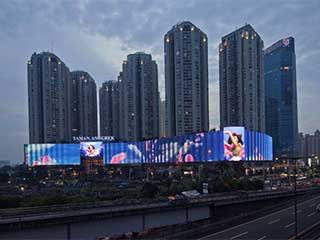 |
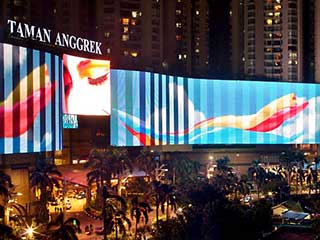 |
| Huge media façade on the Taman Anggrek complex in Indonesia | |
Everything was changing: structures, resolution, sizes of outdoor and roof installations. And the news for years circled around new LED screen projects. Until recently, that is, when the emerging LED curtain technology allowed to significantly simplify screen structure and make it more affordable. As a result, it became feasible to cover huge areas (façades) of commercial buildings with LED curtains.
Media façades started appearing all over the world. The tendency was so noticeable that exactly a year ago in April 2014 a conference on all matters related to media façades was conducted in Germany under the auspices of MAI (Media Architecture Institute). The delegates from various countries presented their projects and discussed the most pressing topics in the area.
There were plenty of topics to discuss: the impact of media facades on architecture, the effects of media facades on the perception of a city benefits and risks of media facades be assessed, sustainable considerations of this technology, current trends and future directions, etc.
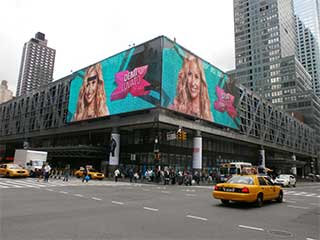 New York's Port Authority bus terminal media façade
New York's Port Authority bus terminal media façadeUnlike new screen installations that need specially allocated spaces in the already cluttered cities, media façades merge into the architectural city landscape naturally. At the same time they drastically transform not only new but even old and recognizable buildings.
The transparent angle of the media façade covers the 553 sq meter area of the excessively “industrial” looking building. This is one of the largest US bus terminals in the center of New York. More than 1.3 million LEDs weaved into a metal mesh are working non-stop 24 hours a week displaying commercials, high-resolution graphics and useful tips for travelers.
Authorities in Europe have long been aware of the irreversible advent of LED digital technology and tried to utilize this technology to improve and lighten-up the cities, to conduct art festivals, to promote new forms of visual art. The numerous resulting art-house projects (like the Dortmund House) created quite a stir in the artistic community by offering opportunities to develop new technological applications and experiment with visual representations.
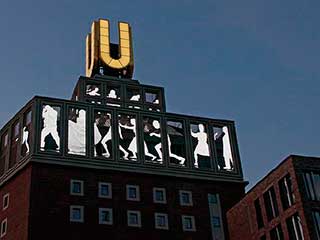 |
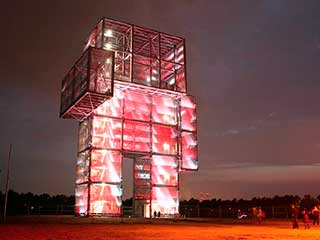 |
| Three-storied 625 sq. m art media façade in the center of Dortmund, Germany | The “Robot” media façade |
Or consider another unusual media façade project that by now turned into a real symbol of the Rheinland-Pfalz in Germany. The viewing platform in the shape of a robot is completely covered with stainless steel wire with embedded LEDs. The total area of the media façade is nearly 1430 sq. meters.
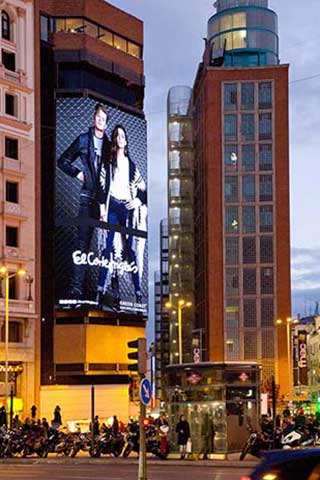 Media façade on El Corte Ingles department store in the center of Madrid, Spain
Media façade on El Corte Ingles department store in the center of Madrid, SpainNaturally, the main purpose of a media façade is to advertise. It is impossible to miss a media façade even from a large distance. And then it becomes impossible to fight subconscious urge to enter a store and buy what was advertised. The perfect example of El Corte Inglés department store in downtown Madrid proves how effective this approach may be. From the time when Daktronics installed a 194 sq. m LED structure (SMD, pixel pitch 10 mm) with Full HD resolution, the number of visitors to the store tripled.
The review of numerous media façade projects from all over the world continued through the 2014 (Media Architecture Biennale) and ended in Denmark where five projects were selected and awarded recognition and prizes. Among them was a controversial incineration plant project in Roskilde by a well-known architect Erick van Egeraat. From a dull block with a chimney the plant was transformed into surreal art-object that shimmers in the night. Since then it was even included into the UNESCO protected list of architectural structures.
The winner in the “Trends and Prototypes” nomination was the project by Asif Khan and his London-based studio. At the winter Olympics in Sochi (Russia) they presented their “MegaFaces” project: the first “live” 3D LED screen. 11 thousand pistons with LED pixels attached on the tip are moving to shape and illuminate faces – in that case, faces of visitors and fans of the Olympic Games, faces that were literally emerging out of the flat screen surface.
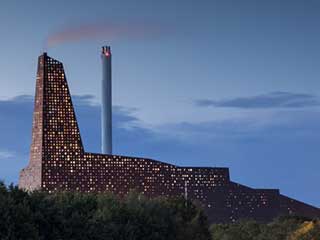 |
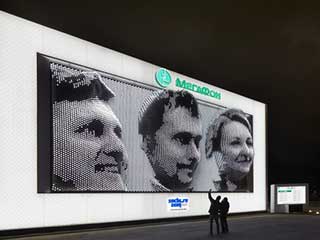 |
| Media façade on the incineration plant in Roskilde, Denmark | “MegaFaces” project |
To decorate cities and mask the unsavory buildings is not the only purpose of media façades. In Madrid the city council approved the law that allowed cinemas and theaters to install large-format media façades to promote their repertoire and offer commercial advertising as well. The proceeds are used to support renovation and upkeep of historical and culturally-significant buildings. What a good initiative, worth imitating everywhere!
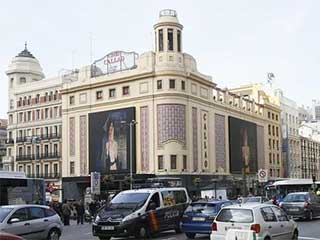 |
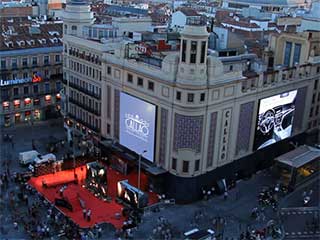 |
| LED screens on the facades of Callao Square in Madrid | |
Naturally, our short list of media façade Projects cannot be complete. There are numerous other examples worth writing about. However the enormous variety of installations speak of creative and engineering potential of the trend. Media façades are only on the early stages of their global expansion, and in the years to come we will witness many worthy LED structures that are making our cities brighter and more attractive.





